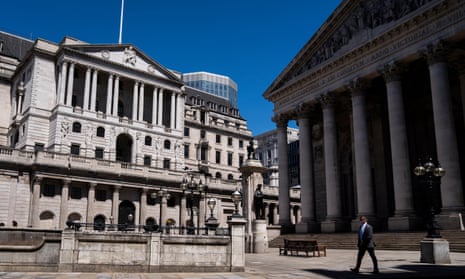The Bank of England has apologised for the involvement of some of its past governors and directors in the slave trade, and pledged to remove all statues and paintings of them from public display in its Threadneedle Street headquarters.
Companies and institutions around the world have been prompted to re-examine their historical ties to slavery and imperialism by recent Black Lives Matter protests, with particular scrutiny in the UK of the statues of slave owners.
The Bank of England was founded as a private bank in 1694 to act as banker to the government. It is not thought to have been directly involved in the slave trade, but at least 25 governors and directors from the 18th and 19th centuries were or had been owners of slaves or were linked to slave trading, according to a database compiled by University College London’s Legacies of British Slave Ownership project.
A Bank of England spokeswoman told the Guardian: “There can be no doubt that the 18th and 19th century slave trade was an unacceptable part of English history.
“As an institution, the Bank of England was never itself directly involved in the slave trade, but is aware of some inexcusable connections involving former governors and directors and apologises for them.”
She added: “The Bank has commenced a thorough review of its collection of images of former governors and directors to ensure none with any such involvement in the slave trade remain on display anywhere in the Bank.”
The Bank said it was “committed to improving diversity and is actively engaging with staff, particularly with our BAME colleagues, to help us identify and shape concrete steps that can be taken now to progress the Bank’s efforts to be as inclusive as possible.”
The UCL database also showed that nearly 100 Church of England clergymen had benefited from links to the slave trade. The church said an apology over historic cases had been issued in 2006, but it reiterated a commitment to tackling slavery “in all its forms today” on Thursday.
Statues of slave owners and imperialists have been a target for campaigners after protesters in Bristol tore down a statue of Edward Colston, and Oriel College, Oxford, voted to remove a statue of Cecil Rhodes.
The Bank of England’s review of images at its Threadneedle Street headquarters will include a number of governors named in the UCL database:
Daniel Giles 1795-1797 (co-mortgagee of estates in Grenada)
Beeston Long 1806-1808 (mortgagee of multiple estates)
Jeremiah Harman 1816-1818 (owned 409 slaves, three estates in St Kitts)
John Palmer 1830-1833 (238 slaves, two estates in Grenada)
Timothy Curtis 1837-1839 (206 slaves, estate in St Vincent)
John Reid 1839-1841 (3,112 slaves, 17 estates in Jamaica, Virgin Islands and others)
Thomson Hankey Jnr 1851-1853 (534 slaves, four estates in Grenada)
Sheffield Neave 1857-1859 (West Indian merchant and son of slave owner)
Bonamy Dobree 1859-1861 (19 slaves, two estates in British Guiana)
Alfred Latham 1861-1863) (402 slaves, three estates in Jamaica, Nevis and Tobago)
Benjamin Buck Greene 1873-1875 (plantation manager in St Kitts and inheritor of slave fortune)
The slave trade was abolished in 1807 across the British Empire, but the ownership of slaves was not finally abolished until 1833. The British government paid £20m in compensation to the former owners of slaves, a vast sum of borrowed money at the time that was only finally repaid in 2015.
Detailed compensation records show the role played by figures in the Bank of England.
Among the largest claimants was John Reid, bank governor from 1839-1841, who shared in compensation of more than £63,000 – equivalent to more than £6m in today’s terms – for giving up ownership of more than 3,100 people.
Thomas Hankey Junior received a share in more than £15,000 in compensation – a sum equivalent to at least £1.4m in today’s terms – in relation to four estates that enslaved 534 people.
